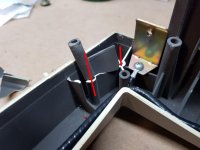Flamin Joe
Experienced Member
Hi,
I was wondering if anyone here knows what type of plastic is used in the IBM 51xx series CRT's? I have a 5153 of which the plastic has become quite brittle and as a result during transit all four corner mounts which attach the CRT tube to the front have cleanly snapped off so I'm looking to re-glue it. The thing is, taking into account the brittleness of the plastic and the amount of stress these four points have in holding the CRT tube in place I'm trying to devise the best way to fix it using the best possible plastic glue/adhesive, which is why I need to know the type, eg PVC, PET, ABS etc..etc.
The idea I have so far is to glue a 4mm wide dowel in each of the places where the plastic is cracked (taking into account they will need to be shorter for the part where the CRT tube mounts) as well as of course gluing along the crack. Then I plan to use either an epoxy filler or hot glue to go over not only the crack line but also any gaps going right down. My thoughts on this is to try and create a strong base to reinforce the already brittle plastic.

My thinking too into the type of glue to use is that I'm hoping to be able to use a plastic cement glue which breaks down or "melts" the plastic and fuses back together when it dries. In that case I was considering using plastic dowels instead of metal which would fuse to the plastic inside creating what I think would be a nice strong bond. I've had mixed results in the past using other glues so I'm quite liking this idea. Thoughts?
I was wondering if anyone here knows what type of plastic is used in the IBM 51xx series CRT's? I have a 5153 of which the plastic has become quite brittle and as a result during transit all four corner mounts which attach the CRT tube to the front have cleanly snapped off so I'm looking to re-glue it. The thing is, taking into account the brittleness of the plastic and the amount of stress these four points have in holding the CRT tube in place I'm trying to devise the best way to fix it using the best possible plastic glue/adhesive, which is why I need to know the type, eg PVC, PET, ABS etc..etc.
The idea I have so far is to glue a 4mm wide dowel in each of the places where the plastic is cracked (taking into account they will need to be shorter for the part where the CRT tube mounts) as well as of course gluing along the crack. Then I plan to use either an epoxy filler or hot glue to go over not only the crack line but also any gaps going right down. My thoughts on this is to try and create a strong base to reinforce the already brittle plastic.

My thinking too into the type of glue to use is that I'm hoping to be able to use a plastic cement glue which breaks down or "melts" the plastic and fuses back together when it dries. In that case I was considering using plastic dowels instead of metal which would fuse to the plastic inside creating what I think would be a nice strong bond. I've had mixed results in the past using other glues so I'm quite liking this idea. Thoughts?
